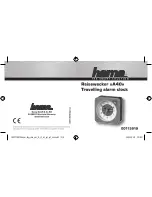Reviews:
No comments
Related manuals for CV212-14

A40
Brand: Hama Pages: 10

940-181
Brand: Marquant Pages: 10

WMSTR-WR-P01
Brand: LST Pages: 2

SS-1200AV
Brand: MyTek Pages: 16

H2O
Brand: Myron Mixon Smokers Pages: 16

aWAKE
Brand: KREAFUNK Pages: 46

Titanus Micro-Sens
Brand: WAGNER Pages: 238

VT-SMKC1
Brand: Vitek Pages: 4

430 Series
Brand: Ultra Start Pages: 12

SCR2469BT
Brand: Sylvania Pages: 24

MEGA 150
Brand: Junghans Pages: 1

FRWM 100 WW
Brand: Jung Pages: 108

GT3200ST
Brand: PORTMAN Pages: 28

DD2+
Brand: Skybrake Pages: 2

SM-24-L
Brand: Town Food Service Equipment Pages: 12

KA1000
Brand: Krown Pages: 20

MR-2602
Brand: Secutron Pages: 52

PE Series
Brand: Exelgard Pages: 2

















